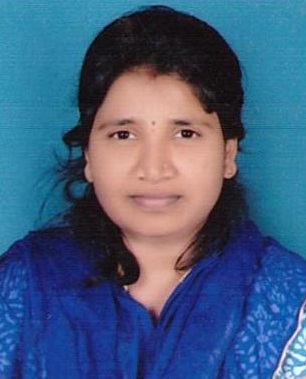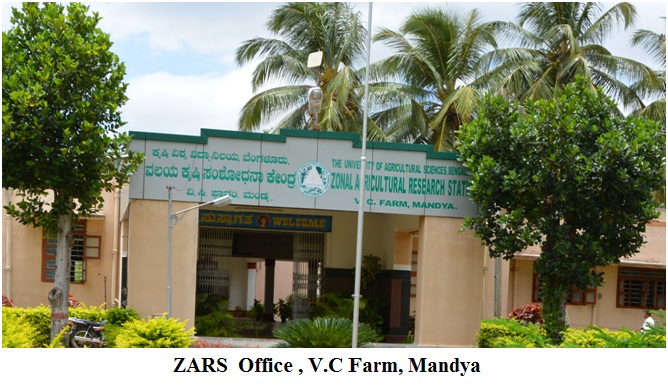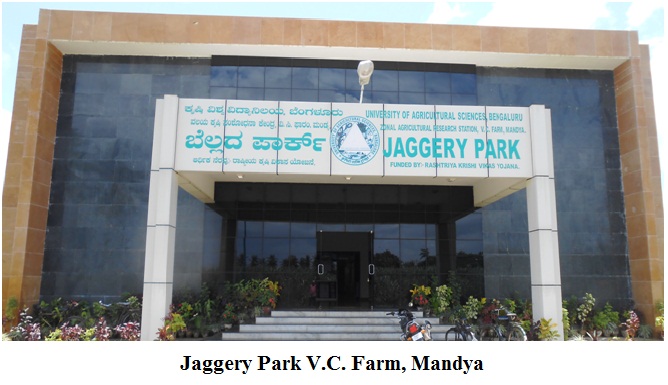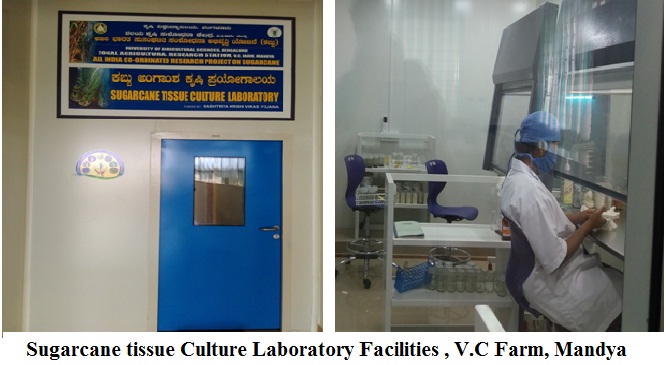About the Centre
Zonal Agricultural Research Station, Mandya (ZARSM) under the
canopy of University of Agricultural Sciences, Bengaluru (UASB,
Karnataka) and it is located at about 11km from Bangalore-Mysore
highway, en route to Melukote. Centre is constantly striving towards
the excellence in research and extension in the field of
agriculture. The station is showing persistent efforts in research
and development and has evolved many high yielding and disease
resistant varieties in sugarcane, rice, maize, small millets and
forage crops. Since its inception in 1931, the centre has been the
hub of sugarcane research in the University and has shown keen
interest in educating and creating awareness among the farmers
through field demonstrations and extension activities. The All India
Coordinated Research Project on sugarcane was established at ZARS,
V. C. Farm, Mandya in the year 1972. Since from its establishment,
it has been playing a pivotal role in the development of improved
varieties, agronomic management practices and plant protection
measures for the zone. Geographically the centre is placed between
12 o45' to 13 o57' North latitude and 76 o45' to 78 o24' East longitude
and it is at an altitude of 695 m above MSL. The centre received 721
mm mean annual rainfall in 42 rainy days and is unevenly
distributed. Hence, crop was fully raised under external irrigation
from Krishna Raja Sagar Dam. April was the hottest month with mean
maximum temperature of 31.3 oC while, January is a coldest month
with mean minimum temperature of 14.3 oC. Both, mean maximum and
minimum temperature are within the range of sugarcane cardinal
temperature range and hence, sugarcane is a major crop in this area
and mainly planted in June-November and also in January – February.
The best time to visit centre is during September-October.
Contact Details:
 |
Mr S N Swami Gowda
Breeder and Scheme Head
AICRP(Sugarcane)
09341156455
swamygowdavcf@gmail.com
|
|
 |
Mrs. Sunitha B. P.
Technical Assistant
Mob:7760933795
sunithabpswamy@gmail.com
|
|
 |
Mr. A. Ramesha
Technical Assistant
Mob: 9035599498
|
|
Achievements
Mid late varieties released by the centre and their salient
characters
-
CoVC 99463 – High yielding (70-80 t/acre), high tillering, better quality, suitable for wide row planting, good ratooner, drought tolerant and good for jaggery making.
-
VCF 0517 (CoVC 14061) – Recently released variety, high yielding (80-90 t/acre), high tillering, better quality, suitable for wide row planting, high jaggery yield and quality and good rationing ability. It occupied 80 % of the area in Southern Karnataka.
-
CoVC 16062- high yielding (70-80 t/acre), high tillering, good quality Sugarcane variety with drought tolerant, Good for Jaggery making and suitable for wide row spacing.
-
CoVC 18061- Non flowering, high yielding (70-80 t/acre), better quality, excellent for Jaggery making, better sucrose content and good ratooner. It is under Farm trial in Zone 6 of Southern Karnataka.
- Co 62175 – High yielding (70-80 t/acre), good rationing ability,
drought tolerant, wide range of adoptability, suitable for
problematic and waterlogged soils and performed better under wide
row planting.
- Co 86032 – High yielding (60-70 t/acre), better quality, good
for jaggery making, high tillering, good rationing ability, suitable
for wide row planting, sparse and late flowering and only variety
suitable for year round planting.
- Co 7804 – High yielding (60-65 t/acre), sparse and late
flowering, better for jaggery making, resistant to red rot, but not
suitable for problematic soils and drought situation.
- Co 8371 – High yielding (70-80 t/acre), good quality, good
ratooner, drought tolerant, high jaggery yield, not suitable for
water logged situation and wide row planting.
- CoVC 2003-165 – High yielding (60-70 t/acre),High tillering,
suitable for wide row planting, good ratooner, non-lodging and early
vigour.
- CoVC 99463 – High yielding (70-80 t/acre), high tillering,
better quality, suitable for wide row planting, good ratooner,
drought tolerant and good for jaggery making.
- VCF 0517 – Recently released variety, high yielding (80-90
t/acre), high tillering, better quality, suitable for wide row
planting, high jaggery yield and quality and good rationing ability.
Early variety released by the centre and their salient characters
-
CoVC 16061- Early Maturing, high tillering variety, high yielding( 60-65 t/acre), Better quality, good for Jaggery making, Better sucrose content, Good ratooner, Drought tolerant and Suitable for wide row spacing(5 ft)
Cultural Practices adopted by farmers
- Farmers adapted planting during June-July due to availability of
canal water followed by October-November and January-February
planting in Cauvery Command Area.
- Pre-emergent application of Metribuzin (70%) @ 1.0 kg a.i. ha-1
or atrazine (50%) @ 1.9 kg a.i. ha-1 or combination of atrazine +
2,4-D and trash mulching found effective in control of weeds.
- Point placement of urea super granules @ 250 kg/ha found enhance
N use efficiency.
- Combined application of organic manures and inorganic
fertilizers found to enhance sustainability.
- French bean, soybean cv monetta, KB-79 found to be best for
intercrops in sugarcane.
- Application of Azatobacter @ 2.0 kg ha-1 found to increase the
cane yield.
- Trash mulching @ 6 t/ha found effective in mitigating drought
effects.
- Sugarcane was found to respond to applied potassium only upto
150 kg/ha.
- Integrated use of pressmud cake @ 4 t ha-1, Azatobacter @ 5 kg
ha-1 with recommended (250 kg N ha-1) found ecologically viable.
- Application of ethrel @ 750 PPM found to control flowering in
sugarcane.
- 75% nutrients through inorganic and 25% through organic source
were ideal to achieve higher cane yield and sucrose percentage.
- Metribuzine at 0.6 kg a.i./ha as pre-emergent spray followed by
2,4-D 1.0 kg a.i./ha at 45 DARI was effective in controlling weeds
and realizing higher cane yield in ratoon crop.
- 6 feet wide row planting in sugarcane given on par yield as that
of conventional 3 feet planting. It also facilitates mechanization
of all IC operations with power tiller/tractor mounted implements.
- Sub-surface drip fertigation in sugarcane found to enhance
sugarcane yield up to 45-50% with 50% saving in irrigation water.
- Use of IDM module in Sugarcane found effective in disease
management.
- Wooly Aphid resistant variety CoVC 2003-165 was released for
Cauvery Command Area.
- Developed mass multiplication technique for Micromus igorotus.
- Application of systemic chemicals Imidacloprid 100 gm a.i/ha or
Thiomethoxam 50 a.i./ha found effective in control of wooly aphids.
- Among the new insecticide molecules granular application of
Chlorantraniliprole 0.4G @ 22.5Kg/ha and Fipronil 0.3G @ 25.0 Kg/ha
at the time of planting and 60 days after planting found effective
in the management of ESB.






